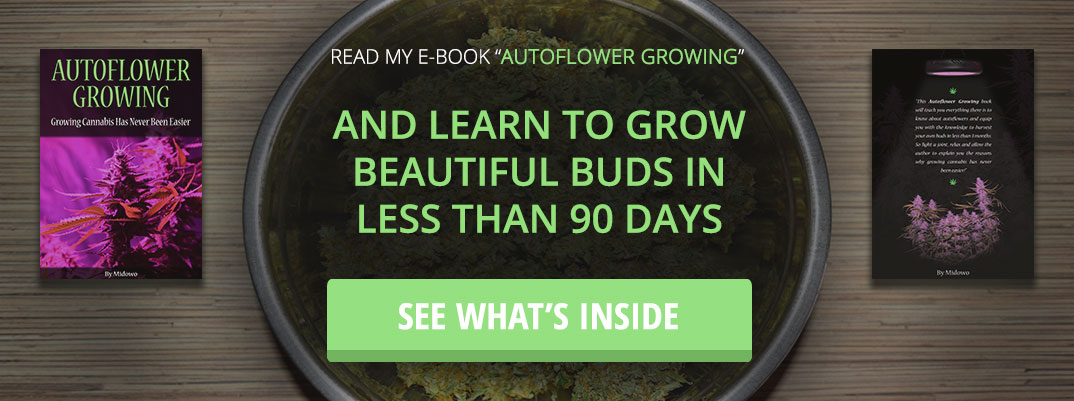Growing autoflower cannabis in coco coir is the ultimate combination of fast-growing cannabis with optimal nutrition uptake.
For those looking for the experience of growing in soil without all the downsides of insects and waiting for your soil to correct itself as you flush excess nutrients, then look no further than coco coir.
Coco coir is still a mystery to some new growers as it starts to get widely adopted across the world.
It’s versatile in that it can be used on its own or added into potting soil for extra drainage.
If you’re looking to grow your autoflower in coco coir it’s a great starter medium for those not familiar or comfortable with soil growing.
What exactly is coco coir?
Quite simply coco coir is ground-up coconut husks that either come loose like mulch or as a solid brick. If the coco comes loose then it is generally premixed with some form of potting soil.
A lot of manufacturers are now using coco instead of peat moss (its greatest competitor) as it is environmentally friendlier to produce.
Coco coir is naturally anti-fungal and insects hate living in it. This makes it an excellent deterrent against insects.
Coco doesn’t retain water which makes it excellent for hydro grows.
The reason you don’t use soil in hydroponics is that often the soil (or the peat moss added to it) will hold that moisture in, causing root rot. This is why coco is being added to soil mixes as it reduces moisture retention and soil compaction, allowing air to dry out the mix which keeps your roots happy.
Additionally, coco hangs on to nutrients pretty well, which means you can give your plants less fertilizer.
Gave your plant too strong of a nutrient mix? Flushing is also easy as drainage capabilities are much higher than those found in soil.
If you’re looking for a premixed coco coir medium expect to pay more than if you were just to get your own coco bricks and blend it yourself. It is a bit more tedious to break up and rehydrate the bricks than to just go to a grow store and pick up a bag that’s already done.
If the convenience is worth it to you there is no reason not to. Some growers just like more control over their processes.
How to prepare coco coir for your plants
Rehydrating coco blocks
If you are buying the coco blocks and plan on rehydrating them then keep reading, otherwise jump down to the paragraph about buffering.
Rehydrating your coco should be the first step in getting it ready for your autoflowers.
Simply submerge the coco into water and since it loves water, it should absorb it and create a mush that you can then push through a screen.
The idea is to get rid of all the little pieces of coco as they hold on to too much water.
Cation sites and buffering
You’re going to need to buffer your coco coir after rehydrating it.
Essentially, your cannabis plant uptakes nutrients from the soil that are bioavailable, this leaves the soil depleted. To refill these areas with nutrients there are cation exchange sites that turn the nutrition you provide the soil into bioavailable nutrients for your plant.
The cation exchange sites in coco are loaded with potassium and sodium, however, there is no calcium and magnesium present in the medium.
When you add calcium and magnesium to coco, it unlocks the potassium and sodium for absorption to the plant and absorbs the cal-mag that you added. This is called a cation exchange and is necessary because coco coir does not have any calcium or magnesium in it.
Calcium and magnesium have a very strong ionic bond and will stop any further cation exchanges, this means any nutrients you add to the coco mixture will be absorbed in the rations you add them in.
All you need to do is soak your coco coir in a cal-mag solution to provide that buffering in the cation exchange sites.
Once you do this step you won’t have to worry about any buffering issues going forward. The electrical conductivity should be somewhere around 1200 PPM and your PH should not exceed 6.3.
Beginner growers may not realize this step and will find that they are having a hard time getting their nutrient ratios right.
What will happen is that any cal-mag you add to your coco while growing the plant will release the sodium and potassium but absorb the calcium and magnesium. This adds extra sodium and potassium to your plant but the cal-mag won’t be bioavailable for the plant to absorb, causing deficiencies and other issues.
Perlite and vermiculite
These are two common items used in the gardening community and are worth a mention in a coco guide.
Even though coco coir has excellent drainage capabilities, it can also hold on to quite a bit of water (especially the smaller pieces). Some growers add perlite to their potting mix as it further increases drainage without interfering with the coco’s biodiversity.
Don’t add vermiculite to your coco mixture as it does the opposite of perlite and actually retains water. You’ll often see vermiculite as a filler in some potting soils. Be sure not to confuse the two of these.
Once these steps are complete ensure that you flush your coco with plain water until the electrical conductivity (EC) is aligned for your plants.
Since you are soaking the coco in a high EC solution you’ll more than likely need to bring it down. For example, if you are putting seedlings into the coco you generally don’t want an EC of more than 400 PPM (0.4EC) as they can be subject to nutrient burn at higher ranges.
How to water and feed your cannabis plants in coco coir
Coco is one of those growing mediums that dries out quickly. Because it allows such a large amount of air through it and its water retention is low, you will have to water your plants often.
Be sure not to let it dry out fully as nutrient salts will start to build up and that has the potential to cause some issues with your autoflowers.
Your nutrient solution should be standard in regards to the growing schedule you have at hand.
Using an electrical conductive (EC) reader will help determine if the plant is getting enough nutrition for whatever stage of the cycle it is in.
Ensure that your PH also stays within the range of 5.9-6.3 so that all of your nutrients remain bioavailable.
You’ll notice with coco that the larger your plant gets, the more you will have to water it.
Depending on the strain and how much you’re pushing your plant it wouldn’t be unusual to water your plants at least twice a day. This is why growers usually set up an automatic watering system, of course, if you have a small number of plants then hand watering isn’t tedious.
Why should you use coco for your autoflowering cannabis plants?
With so many things to remember, beginner autoflower cannabis growers benefit from coco as it is forgiving when mistakes are made and almost as automatic as growing autoflower strains.
This is a great way for beginner growers to interact more with their plants as frequent watering and quick nutrient uptake will have you paying more attention.
Frequently asked questions about growing autoflowers in coco
How can I figure out the electrical conductivity (EC) of the coco soil mixture?
The easiest way would be to flush your plant with plain water and catch some of the liquid that escapes out of the bottom of the pot. Using an EC meter, take a reading of the water and use that as an indicator of what’s going on in the soil.
If your EC is too high then continue flushing until you reach the desired range.
Too low? Increase your nutrient solution, but don’t go crazy. You don’t want to stress your plant out too much.
Is it okay to overwater my cannabis plants and let them sit in the overflow from the pot?
It is important to have any runoff water drained immediately. The water will saturate the coco and change the nutrient ratios because the runoff contains extra nutrients that were flushed from the watering.
What is the PH of coco coir?
Coco comes in at a neutral PH (5.8-6.4) which is why growers love it so much.
Something like peat moss tends to be acidic because it comes from places like bogs and swamps, which are naturally acidic.
Cannabis loves more of a neutral PH and this makes it easy to manage that aspect of watering.
Is coco coir good for hydroponic systems?
It is an excellent growing medium for hydroponic systems and is used in a variety of applications.
Make sure you get the coco that is made for hydroponic systems, you don’t want the smaller chunky-like pieces.
You can then pack it in your net pots and you should be good to go.







